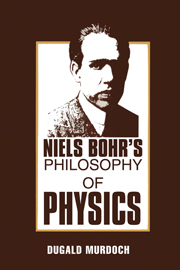Book contents
- Frontmatter
- Contents
- Dedication
- Preface
- Acknowledgements
- 1 Wave-particle duality
- 2 Niels Bohr and wave-particle duality
- 3 From duality to complementarity
- 4 The meaning of complementarity
- 5 The foundations of kinematic-dynamic complementarity
- 6 Bohr's theory of measurement
- 7 Bohr's theory of properties
- 8 Einstein versus Bohr
- 9 The sequel to the Bohr-Einstein debate
- 10 Bohr's philosophy of physics
- 11 An appraisal of Bohr's philosophy of physics
- Notes
- Index
5 - The foundations of kinematic-dynamic complementarity
Published online by Cambridge University Press: 01 June 2011
- Frontmatter
- Contents
- Dedication
- Preface
- Acknowledgements
- 1 Wave-particle duality
- 2 Niels Bohr and wave-particle duality
- 3 From duality to complementarity
- 4 The meaning of complementarity
- 5 The foundations of kinematic-dynamic complementarity
- 6 Bohr's theory of measurement
- 7 Bohr's theory of properties
- 8 Einstein versus Bohr
- 9 The sequel to the Bohr-Einstein debate
- 10 Bohr's philosophy of physics
- 11 An appraisal of Bohr's philosophy of physics
- Notes
- Index
Summary
Having discussed the meaning of complementarity in general and wave particle complementarity in particular, I wish now to explicate Bohr's subtle argument for the thesis that certain pairs of classical concepts which are mutually compatible in classical physics are mutually exclusive in quantum physics, i.e. the thesis of kinematic–dynamic complementarity. It is generally held that Bohr regarded the mutual exclusiveness in question as being not only epistemic but also ontic or semantic, in the sense that the uncertainty principle expresses a restriction not only on the joint measurability of canonically conjugate observables but also on the joint instantiation of the properties corresponding to these observables. I shall consider the question of the ontic or semantic construal of kinematic–dynamic complementarity in Chapter 7. Bohr's argument for complementarity in the epistemic sense is, however, more fundamental: it goes to the heart of his theory of observation and measurement in quantum physics. What, then, is Bohr's argument?
The mutual exclusiveness of kinematic and dynamic properties
Kinematic and dynamic attributes in quantum mechanics are mutually exclusive in the sense that they cannot be simultaneously measured; they are, in this sense, epistemically incompatible. Why did Bohr think this? His reasons may seem intricate, but they are basically quite simple. Two main factors, he maintains, account for the epistemic incompatibility: (a) measurements of these two different sorts of properties require mutually exclusive experimental arrangements, incompatible measurement procedures; (b) the indeterminability of the interaction between the object and the instrument of measurement precludes extrapolation of the different measurement results to one and the same time.
- Type
- Chapter
- Information
- Niels Bohr's Philosophy of Physics , pp. 80 - 108Publisher: Cambridge University PressPrint publication year: 1987



